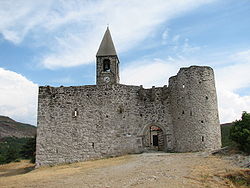- Church of the Holy Trinity, Hrastovlje
-

Country Slovenia Denomination Roman Catholic History Founded 13th century Dedication Holy Trinity Architecture Style Gothic Administration Parish Predloka Diocese Koper Province Ljubljana The Church of the Holy Trinity (Slovene: Cerkev Svete Trojice) is a historical building in Hrastovlje, Slovenia, dating from the 13th century. Johannes de Castua painted it with frescoes in 1490, some of which include letters in the Glagolitic script.[1] The most famous of these frescoes is a Dance of Death or "Danse Macabre".[2] The church stands behind a wall that the local population built to protect itself from Turkish attacks in the 16th century.
History
The church and wall were built on bare rock, and for this reason do not have deep foundations. The church is built mostly out of stone, as is typical for the entire coastal region. The stones were never entirely covered in an outer layer of plaster, and it is thus possible to see how the church was built. One can see that top of the church spire was rebuilt at some time, although it is not known why. The church is topped with tiles made of thick plates. These are characteristic for older roofs in the Mediterranean region.
The church does not have many windows as a result of the local weather conditions. In summer, a room with a small window was protected from the sun, while in winter it was protected from the bora. Because of the low number of windows, the inside of the church is however very dark. In 1896, a hole was knocked in the northern wall to create a new window, but unfortunately some of the frescoes in the church were destroyed at the same time.
Despite the lack of windows, the church nonetheless used to be better lit than it is today. This is the result of the addition of the powerful outer wall, which robs the church of much of its light.
Because of its height, the church is classed as a multi-layered church. This type of church was only built in Slovenia during the Gothic period; there are no Romanesque examples. Such churches can be found for example in Ptujska Gora, and in Slovenske Gorice. The church in Hrastovlje differs from all other pilgrim churches in that its bell-tower is located on the western side and in that all other pilgrim churches have small wooden towers.
The church is 11.7 metres long and 6.05 metres wide and thereby one of the smallest churches in the area. It is not even as large as the average village church. Some claim that the church is an example of Istrian Renaissance architecture from the second half of the 15th century.
The appearance of the eastern entrance to the church, as we know it today, dates back to around 1776. The original entrance was probably next to the bell-tower.
The church wall
The church was probably built with a wall, but it was strengthened by Leander Zarotus. It is 8 metres thick and is made out of limestone. It would be hard to determine exactly when the wall was built, but it is estimated that it was constructed some time around the end of the 15th century, therefore definitely later than the church itself. The wall encloses the entire building and only the bell-tower with its cross peek out over the top. It was first built as a defensive measure against the Turks and is shaped like an irregular rectangle. There are two towers in the corners. One stands in the northeast, the other protects the entrance from the village side. Two layers for archers can be recognised in the towers; the walls must at some time have been taller, because it was possible to place three layers of archers on them. There was also a balcony above the entrance gates, from which it was possible to defend the church by throwing stones or pouring boiling water on attackers.
References
- ^ Norm Longley, The Rough Guide to Slovenia (2004), p. 189.
- ^ Tomislav Vignjević, Ples smrti: prispevki k ikonografiji mrtvaškega plesa v Bermu in v Hrastovljah. Koper: Založba Annales, 2007. With summaries in Italian and English: "La danza della morte: contributi all'iconografia della danza della morte di Vermo e Cristoglie"; "The Dance of Death: contributions to the iconography of the dance of death in Beram and Hrastovlje". ISBN 978-961-6033-91-6 . Reviewed by Barbara Španjol-Pandelo in Ikon, 1 (2008), pp. 295-298.
Coordinates: 45°30′34.83″N 13°54′6.7″E / 45.509675°N 13.901861°E
Categories:- Churches in Slovenia
- Istria
- Renaissance architecture
- 13th-century architecture
- Gothic architecture in Slovenia
Wikimedia Foundation. 2010.

